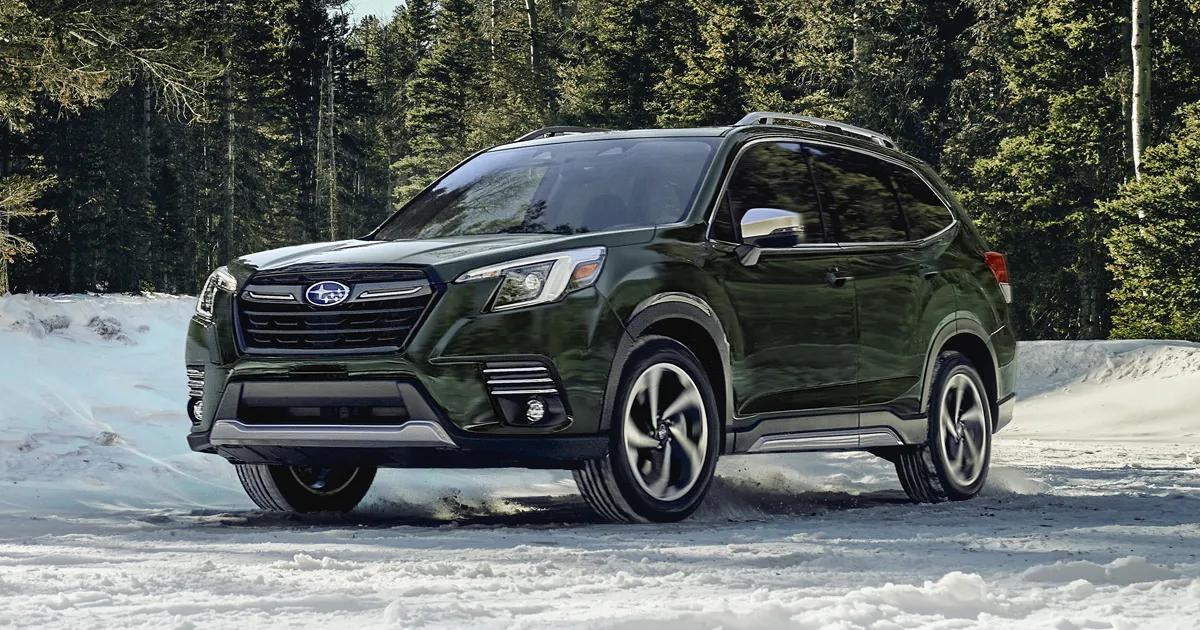 Subaru Forester 2023 Continuously variable transmission Base
Subaru Forester 2023 Continuously variable transmission Base
The standard version of the 2023 Subaru Forester comes with a Continuously Variable Transmission (CVT), which is intended to improve driving performance and fuel efficiency. Driving will be responsive and smooth thanks to its CVT’s smooth and effective power delivery. A solid option for both everyday commuting and outdoor adventures, the base Forester is paired with Subaru’s famed Symmetrical All-Wheel Drive technology to provide exceptional traction and stability in a variety of road and weather conditions. The base 2023 Subaru Forester model’s CVT balances performance and fuel economy, making it a useful and adaptable SUV for a variety of drivers.
2023 Subaru Forester Specs, Price, Features, Mileage (Brochure)
Continuously variable transmission
WARNING
Do not shift from the “P” or “N” position into the “D” or “R” position while depressing the accelerator pedal. This may cause the vehicle to jump forward or backward.
CAUTION
- Observe the following precautions. Otherwise, the transmission could be damaged.
- Shift into the “P” or “R” position only after the vehicle has completely stopped.
- Do not shift from the “D” position into the “R” position or vice versa until the vehicle has completely stopped.
- Do not race the engine for more than 5 seconds in any position except the “N” or “P” position when the brake is applied or when chocks are used in the wheels. This may cause the transmission fluid to overheat.
- Never move the vehicle as follows. Doing so may result in an unexpected accident or malfunction.
- Moving rearward by inertia with the select lever set in a forward driving position.
- Moving forward by inertia with the select lever set in the “R” position.
- When parking the vehicle, first securely apply the parking brake and then place the select lever in the “P” position. Avoid parking for a long time with the select lever in any other position as doing so could result in a dead battery.
Continuously variable transmission features
The continuously variable transmission is electronically controlled and provides an infinite number of forward speeds and 1 reverse speed. It also has a manual mode or an “L” position.
NOTE
- When the engine coolant temperature is still low, the transmission will shift at higher engine speeds than when the coolant temperature is sufficiently high in order to shorten the warm-up time and improve driveability. The gearshift timing will automatically shift to the normal timing after the engine has warmed up.
- Immediately after the transmission fluid is replaced, you may feel that the transmission operation is somewhat unusual. This results from the invalidation of data that the onboard computer has collected and stored in memory to allow the transmission to shift at the most appropriate times for the current condition of your vehicle. Optimized shifting will be restored as the vehicle continues to be driven for a while.
- continuous heavy load conditions such as when towing a camper or climbing a long, steep hill, the engine speed or the vehicle speed may automatically be reduced. This is not a malfunction. This results from the engine control function maintaining the cooling performance of the vehicle. The engine and vehicle speed will return to a normal speed when the engine is able to maintain the optimum cooling performance after the heavy load decreases. Driving under a heavy load must be performed with extreme care. Do not try to pass a vehicle in front when driving on an uphill slope while towing.
- The continuously variable transmission is a chain-type system that provides superior transmission efficiency for maximum fuel economy. At times, depending on varying driving conditions, a chain operating sound may be heard that is characteristic of this type of system.
Select lever
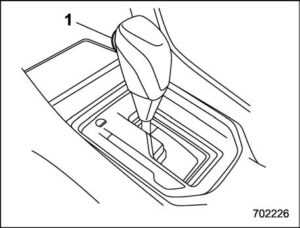
Type A
Select lever button
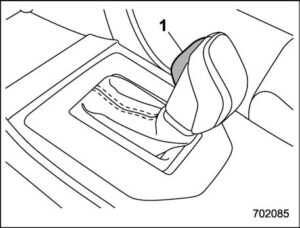
Type B
Select lever button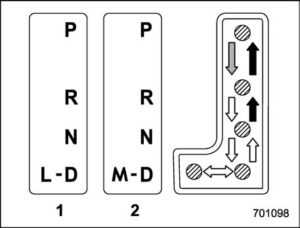
- Models with “L” position
- Models with manual mode
With the brake pedal depressed, shift while pressing the select lever button in.
- Shift while pressing the select lever button in.
- Shift without pressing the select lever button.
The select lever has four positions, “P”, “R”, “N”, “D” and it also has an “L” or “M” gate.
NOTE
For some models, to protect the engine while the select lever is in the “P” or “N” position, the engine is controlled so that the engine speed may not become too high even if the accelerator pedal is depressed hard.
P (Park)
This position is for parking the vehicle and starting the engine. In this position, the transmission is mechanically locked to prevent the vehicle from rolling freely. When you park the vehicle, first apply the parking brake firmly, then shift into the “P” position. Do not hold the vehicle with only the mechanical friction of the transmission. To shift the select lever from the “P” position to any other position, you should depress the brake pedal fully then move the select lever. This prevents the vehicle from lurching when it is started.
R (Reverse)
This position is for backing the vehicle. To shift from the “N” to the “R” position, stop the vehicle completely then move the lever to the “R” position while pressing the select lever button in. When the ignition switch has been turned to the “ACC” position, the movement of the select lever from the “N” to “R” position is only possible by depressing the brake pedal.
N (Neutral)
This position is for restarting a stalled engine. In this position, the transmission is neutral, meaning that the wheels and transmission are not locked. Therefore, the vehicle will roll freely, even on the slightest incline unless the parking brake or foot brake is applied. Avoid coasting with the transmission in neutral. Engine braking has no effect in this condition.
WARNING
Do not drive the vehicle with the select lever in the “N” (neutral) position. Engine braking has no effect in this condition and the risk of an accident is consequently increased.
D (Drive)
This position is for normal driving. The transmission shifts automatically and continuously into a suitable gear according to the vehicle speed and the acceleration you require. Also, while driving up and down a hill, the transmission assists and controls the driving performance and engine braking while corresponding to the road grade. When more acceleration is required in the “D” position, depress the accelerator pedal fully to the floor and hold that position. The transmission will automatically downshift. In this case, the transmission will operate like a conventional automatic transmission. When you release the pedal, the transmission will return to the original gear position. For models with manual mode, if one of the shift paddles behind the steering wheel is operated while driving in the “D” position, the transmission will temporarily switch to the manual mode. In this mode, you can shift into any gear position using the shift paddles. Once the vehicle speed stabilizes, the transmission will switch from the manual mode back to the “D” position for normal driving.
Selection of manual mode (if equipped)
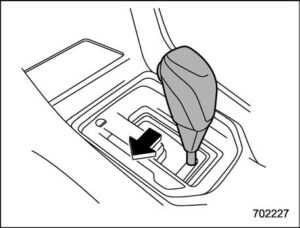
Type A
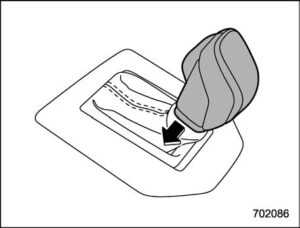
Type B
With the vehicle either moving or stationary, move the select lever from the “D” position to the “M” position to select the manual mode.
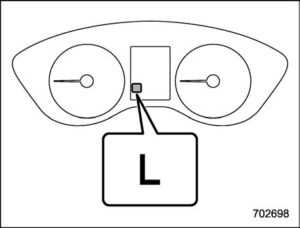
Select the lever/gear position indicator
- Upshift indicator
- Downshift indicator
- Gear position indicator
When the manual mode is selected, the gear position indicator and upshift indicator and/or downshift indicator on the combination meter illuminate. The gear position indicator shows the currently selected gear in the following range.
- 1st-to-7th-gear range (except for Subaru Forester Wilderness models)
- 1st-to-8th-gear range (for Subaru Forester Wilderness models)

The upshift and downshift indicators show when a gear shift is possible. When the upshift indicator “ ” illuminates, upshifting is possible. When the downshift indicator “ ” illuminates, downshifting is possible. When both indicators illuminate, upshifting and downshifting are both possible. When the vehicle stops (for example, at traffic signals), the downshift indicator turns off. Gearshifts can be performed using the shift paddle behind the steering wheel.To deselect the manual mode, return the select lever to the “D” position from the “M” position.
Shift lock function
- The shift lock function helps prevent the improper operation of the select lever.
- The select lever cannot be operated unless the ignition switch is turned to the “ON” position and the brake pedal is depressed.
- The select lever cannot be moved from the “P” position to any other position before the brake pedal is depressed. Depress the brake pedal first, and then operate the select lever.
- Only the “P” position allows you to turn the ignition switch from the “ACC” position to the “LOCK”/“OFF” position and remove the key from the ignition switch.
- if the ignition switch is turned to the “ACC” position while the select lever is in the “N” position, the select lever may not be moved to the “P” position without depressing the brake pedal and pressing the select lever button.
Shift lock release
If the select lever cannot be operated, turn the ignition switch back to the “ON” position then move the select lever to the “P” position with the select lever button pressed and the brake pedal depressed. If the select lever does not move after performing the above procedure, check and confirm the following and release the shift lock accordingly.
When the select lever cannot be shifted from “P” to “N”:
- When the select lever cannot be shifted from “N” to “R”, “P”: Place the ignition switch in the “ACC” position, then move the select lever to the “P” position with the brake pedal depressed. If the select lever still does not move, If the shift lock cannot be released without using the shift lock release button in the above cases, there may be a malfunction in the shift lock system or the vehicle control system. Contact a SUBARU dealer for an inspection as soon as possible.
Shift lock release using the shift lock release button Perform the following procedure to release the shift lock.
- Apply the parking brake and stop the engine.

- Wrap the tip of a flat-head screwdriver with vinyl tape or cloth and use it to remove the shift lock cover. The shift lock release button is located under the shift lock cover.

- While depressing the brake pedal, insert a screwdriver into the hole, press the shift lock release button using a screwdriver, and then move the select lever.
If the select lever does not move after performing the above procedure, the shift lock system may be malfunction. Contact a SUBARU dealer for an inspection as soon as possible.
Driving tips
CAUTION
If the accelerator and brake pedals are depressed at the same time, driving torque may be restrained. This is not a malfunction.
- Always apply the foot or parking brake when the vehicle is stopped in the “D” or “R” position.
- Make sure to apply the parking brake when parking your vehicle. Do not hold the vehicle with only the mechanical friction of the transmission.
- Do not keep the vehicle in a stationary position on an uphill grade by using the “D” position. Use the brake instead.
- The engine may, on rare occasions, knock when the vehicle rapidly accelerates or rapidly pulls away from a standstill. This phenomenon does not indicate a malfunction.
SI-DRIVE
SI-DRIVE (SUBARU Intelligent Drive) works to maximize engine performance, control and efficiency. This system consists of two modes: Intelligent (I), Sport (S), and Sport Sharp (S#). By operating the SI-DRIVE switches, the character of the power unit changes.
Intelligent (I) mode
For smooth, efficient performance driving

The linear acceleration characteristic of the Intelligent (I) mode is ideal for normal driving usage. The Intelligent (I) mode provides well-balanced performance with greater fuel efficiency and smooth drive ability without stress. Power delivery is moderate during acceleration for maximum fuel efficiency. This is ideal for around-town driving and situations that do not require full power output. It provides better control in difficult driving conditions, such as slippery roads or loose surfaces, due to gentler throttle response.
Sport (S) mode (if equipped)
For all-around performance driving
For sports-minded drivers, the Sport Sharp (S#) mode offers an exhilarating level of engine performance and control. The throttle becomes more responsive regardless of the engine speed. Delivering maximum driving enjoyment, this mode is ideal for tackling twisting roads and for merging or overtaking other vehicles on the freeway with confidence.
SI-DRIVE switches

Type A SI-DRIVE switches
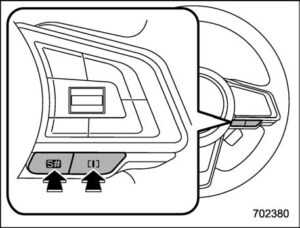
Type B SI-DRIVE switches
- To select the Intelligent (I) mode, press the “I” switch.
- To select the Sport (S) mode, press the “S” switch.
- To select the Sport Sharp (S#) mode, press the “S#” switch.
NOTE
- While the engine is cool, you cannot change to Sport Sharp (S#) mode.
- The next time you turn on the engine, after you turned off the engine in the Sport (S) mode (type A) or Sport Sharp (S#) mode (type B), the SI-DRIVE mode changes to the Intelligent (I) mode.
- If the CHECK ENGINE warning light/ malfunction indicator light illuminates while the engine is running, type A changes to the Sport (S) mode, and type B remains in the state that was in effect before the warning light turned on. In this case, it is not possible to change to another mode.
- If any of the SI-DRIVE indicators blink, the SI-DRIVE system may be malfunction. Contact your SUBARU dealer.
Power steering
Power steering warning light

The power steering system features The vehicle is equipped with an electric power steering system. When the ignition switch is turned to the “ON” position, the power steering warning light on the combination meter illuminates to inform the driver that the warning system is functioning properly. Then, if the engine started, the warning light turns off to inform the driver that the steering power assist is operational.
CAUTION
When the power steering warning light is illuminated, there may be more resistance when the steering wheel is operated. Drive carefully to the nearest SUBARU dealer and have the vehicle inspected immediately.
NOTE
If the steering wheel is operated in the following ways, the power steering control system may temporarily limit the power assist in order to prevent the system components, such as the control computer and drive motor, from overheating.
- The steering wheel is operated frequently and turned sharply while the vehicle is maneuvered at extremely low speeds, such as while frequently turning the steering wheel during parallel parking.
- The steering wheel remains in the fully turned position for a long period of time. At this time, there will be more resistance when steering. However, this is not a malfunction. Normal steering force will be restored after the steering
wheel is not operated for a while and the power steering control system has an opportunity to cool down. However, if the power steering is operated in a non-standard way which causes power assist limitation to occur too frequently, this may result in a malfunction of the power steering control system .wheel is not operated for a while and the power steering control system has an opportunity to cool down. However, if the power steering is operated in a non-standard way which causes power assist limitation to occur too frequently, this may result in a malfunction of the power steering control system.
Braking tips
WARNING
Never rest your foot on the brake pedal while driving. This can cause dangerous overheating of the brakes and needless wear on the brake pads.
When the brakes get wet
When driving in rain or after washing the vehicle, the brakes may get wet. As a result, the brake stopping distance will be longer. To dry the brakes, drive the vehicle at a safe speed while lightly depressing the brake pedal to heat up the brakes.
Use of engine braking
Remember to make use of engine braking in addition to foot braking. When descending a grade, if only the foot brake is used, the brakes may start working improperly because of brake fluid overheating, caused by overheated brake pads. To help prevent this, shift to a lower gear to get stronger engine braking.
Braking when a tire is punctured
Do not depress the brake pedal suddenly when a tire is punctured. This could cause a loss of control of the vehicle. Keep driving straight ahead while gradually reducing speed. Then slowly pull off the road to a safe place.
Brake system Two separate circuits
Your vehicle has two separate circuit brake systems. Each circuit works diagonally across the vehicle. If one circuit of the brake system should fail, the other half of the system still works. If one circuit fails, the brake pedal will go down much closer to the floor than usual and you will need to press it down much harder. A much longer distance will be needed to stop the vehicle
Electronic brake booster
The vehicle is equipped with an electronic brake booster to provide additional braking force. Do not turn off the ignition switch while driving because that will turn off the brake booster, resulting in poor braking power. The brakes will continue to work even
when the brake booster completely stops functioning. If this happens, you will have to depress the pedal much harder than during normal braking, and the braking distance will increase.
NOTE
When the following operations are performed, an operating sound from the electronic brake boost control module may be heard. This is not a malfunction.
- The brake pedal was operated.
- The driver’s door was opened.
- The Eye Sight function was activated.
- Several minutes have passed after the engine stopped.
Supplemental booster function when electronic brake booster fails If there is a malfunction in the braking system, the power for the braking will be stored by controlling the hydraulic pressure of the VDC system. When the brake pedal is depressed while the supplemental booster function is operating, an operation sound and brake pedal vibration may be generated.
Brake assist system
Do not be overconfident about the brake assist. It is not a system that brings more braking ability to the vehicle beyond its braking capability. Always use the utmost care when driving regarding vehicle speed and safe distance.
CAUTION
When you need to brake suddenly, continue depressing the brake pedal strongly to bring the effect of the brake assist.
Brake assist is a driver assistance system. It assists the brake power when the driver cannot depress the brake pedal strongly and the brake power is insufficient. Brake assist generates the brake power according to the speed at which the driver depresses the brake pedal.
NOTE
When you depress the brake pedal strongly or suddenly, the following will occur. However, even though these occur, they do not indicate any malfunctions, and the brake assist system is operating properly.
- You might feel that the brake pedal is applied by lighter force and generates a greater braking force.
- You might hear an ABS operating noise from the engine compartment.
Disc brake pad wear warning indicators
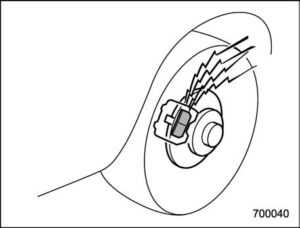
The disc brake pad wears warning indicators on the disc brakes giving a warning noise when the brake pads are worn. If a squeaking or scraping noise is heard from the disc brakes while braking, immediately have your vehicle checked by your SUBARU dealer.
ABS (Anti-lock Brake System)
The ABS prevents the lock-up of wheels which may occur during sudden braking or braking on slippery road surfaces. This helps prevent the loss of steering control and directional stability caused by wheel lock-up. When the ABS is operating, you may hear a chattering noise or feel a slight vibration in the brake pedal. This is normal when the ABS operates. The ABS will not operate when the vehicle speed is below approximately 6 mph (10 km/h).
WARNING
Always use the utmost care in driving overconfidence because you are driving a vehicle with the ABS could easily lead to a serious accident.
CAUTION
- The ABS does not always decrease stopping distance. You should always maintain a safe following distance from other vehicles.
- When driving on badly surfaced roads, gravel roads, icy roads, or over newly fallen snow, stopping distances may be longer for a vehicle with the ABS than one without. Therefore, when driving under these conditions, reduce your speed and leave ample distance from other vehicles.
- When tire chains are installed, stopping distances may be longer for a vehicle with the ABS than one without. Be sure to reduce your speed and maintain a safe distance from the vehicle in front.
- When you feel the ABS operating, you should maintain constant brake pedal pressure. Do not pump the brake pedal since doing so may defeat the operation of the ABS.
ABS self-check
Just after the vehicle is started, you may feel on a brake pedal vibration similar to when the ABS operates, and you may also hear the sound of the ABS working from the engine compartment. This is caused by an automatic functional test of the ABS being carried out and does not indicate a malfunction.
FAQ
What type of transmission does the 2023 Subaru Forester base model come with?
The base model of the 2023 Subaru Forester is typically equipped with a Continuously Variable Transmission (CVT).
What is the benefit of a CVT in the Forester?
A CVT offers smoother and more fuel-efficient power delivery compared to traditional automatic transmissions, enhancing both performance and fuel economy.
Can you manually shift gears with the CVT in the Forester?
Some Forester models may offer a manual mode or paddle shifters that allow you to simulate gear shifts for more control over the transmission.
Does the CVT in the Forester have multiple driving modes?
Subaru often includes different driving modes, such as Normal and Sport modes, to adjust the CVT’s performance characteristics to suit your driving preferences.
Is the CVT in the base Forester paired with Subaru’s Symmetrical All-Wheel Drive system?
Yes, the base Forester typically comes with Subaru’s Symmetrical All-Wheel Drive, providing enhanced traction and stability.
How does the CVT affect fuel economy in the 2023 Subaru Forester?
The CVT contributes to the Forester’s good fuel economy, helping it achieve competitive mileage ratings for its class.
What is the towing capacity of the 2023 Subaru Forester with the CVT?
The Forester’s towing capacity can vary depending on the trim level and equipment, but it’s typically around 1,500 to 3,000 pounds.
Does the CVT require special maintenance in the Forester?
Routine maintenance for the CVT, such as regular fluid changes, may be recommended as per Subaru’s guidelines.
Are there any specific driving tips or guidelines for driving with the CVT in the Forester?
Subaru provides guidelines for optimal CVT operation, such as maintaining proper fluid levels and avoiding excessive towing loads.
Can you expect a smooth and quiet ride with the CVT in the Forester?
Yes, the CVT often contributes to a smooth and quiet driving experience in the Forester.
Is there a CVT warranty for the 2023 Subaru Forester?
Subaru typically offers a powertrain warranty that covers components like the CVT for a certain period or mileage, but the specifics may vary by region and trim.
Does the base Forester come with paddle shifters for manual control of the CVT?
Paddle shifters may be available as an option or on higher trim levels, but they are not always standard in the base model.
Are there any known issues or common maintenance concerns with the CVT in the Forester?
It’s advisable to consult the owner’s manual and follow Subaru’s recommended maintenance schedule to address any potential concerns and ensure the longevity of the CVT.
Can the CVT in the Forester be more fuel-efficient compared to traditional automatic transmissions?
Yes, the CVT is designed to optimize fuel efficiency by continuously adjusting the transmission ratio to the driving conditions, helping to improve gas mileage.
Is the CVT in the Forester responsive when accelerating?
Yes, the CVT often provides a responsive and smooth acceleration, making it well-suited for various driving situations.
Useful Link
View Full User Guide: Subaru Forester 2023 Base User Guide
Download Manuals: https://www.subaru.com/owners/vehicle-resources/manuals.htm
2023 Subaru Forester Specs, Price, Features, Mileage (Brochure)

